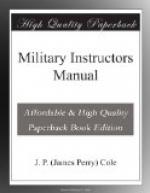23. Are my men drinking water from any but authorized sources?
24. I am here for two purposes: To hold this line under all circumstances, and I do as much damage as possible to the enemy? Am I doing all I can to make this line as strong as possible? Am I as OFFENSIVE as I might be with organized snipers, sniperscopes, rifle grenades, catapults, etc., and patrols?
Defensive Measure Against Gas Attacks.
I. Introduction.
A. General Considerations:
In the absence of suitable means of protection the poison gases used in war are extremely deadly and the breathing of only very small quantities of them may cause death or serious injury. This being the case, it is essential that not the slightest time should be lost in putting on the anti-gas device on the gas alarm being given.
It cannot be too strongly insisted on that the measures to meet hostile gas attacks afford perfect protection, and if they are carried out properly no one will suffer from gas poisoning.
The whole basis of protecting troops against gas lies (a) in keeping the appliances in perfect working order; (b) in learning to adjust them rapidly under all conditions, and (c) in ensuring that every man is given immediate warning. These results can only be attained:
(1) By frequent and thorough inspection
of all protective
appliances.
(2) By thorough instruction and
training in their use.
(3) By every man understanding and
complying with all standing
orders on
the subject of defense against gas.
If these are effectually carried out, there is nothing to fear from hostile gas attacks. Officers must impress this on their men, as an important object of all anti-gas instruction should be to inspire complete confidence in the efficacy of the methods which are adopted.
B. Nature of Gas Attacks:
(1) GAS CLOUDS:
This method of making a gas attack is entirely dependent on the direction of the wind. The gas is carried up to the trenches compressed in steel cylinders. These are dug in at the bottom of the trench and connected with pipes leading out over the parapet. When the valves of the cylinders are opened, the gas escapes with a hissing sound, which, on a still night, can frequently be heard at a considerable distance. It mixes with the air and is carried by the wind towards the opposing trenches, spreading out as it goes forward. A continuous wave of gas and air is thus formed, the color of which may vary:
(a) Because of the weather conditions.
In very dry air it may be
almost transparent
and slightly greenish in color, while in
damp weather
it forms a white cloud.
(b) Because it may be mixed with
smoke of any color.
A cloud attack can only take place when there is a steady but not too strong wind blowing from the enemy’s lines towards our own. A wind between 4 and 8 miles an hour is the most likely condition. An 8-mile wind will carry the gas cloud twice as quickly as a man walks rapidly.




